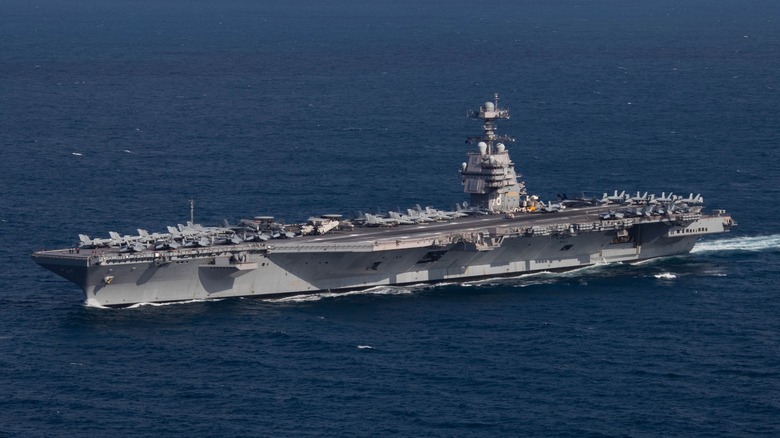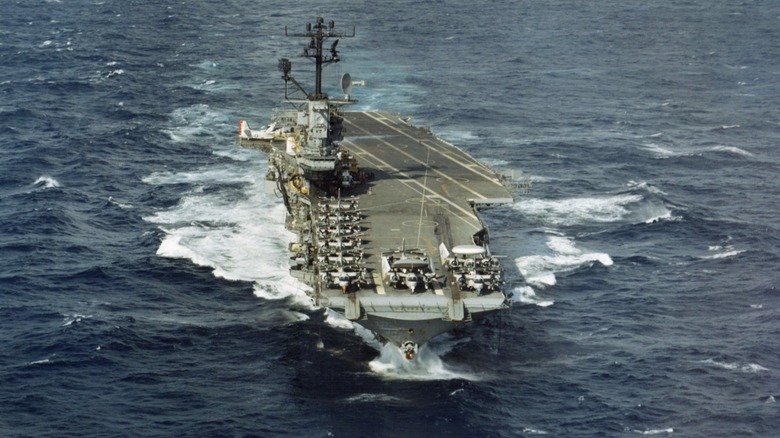How Long Does It Take An Aircraft Carrier To Cross The Atlantic?
When it comes to aircraft carriers, the nation with the most is the United States. The U.S. Navy operates 11 nuclear aircraft carriers of various designs, and more are on the way as the service replaces its aging fleet of Nimitz-class carriers with the new Gerald R. Ford-class carriers. These are massive ships and the largest warships ever constructed in military history. Each Ford-class vessel displaces around 100,000 tons of seawater and measures 1,092 feet in length, with a flight deck width of 256 feet.
That's a lot of ship to move around, but despite its mass, a Ford-class carrier can sail along the ocean surface at an impressive 34.5 mph. Moving such a ship requires a great deal of power, and these carriers are fully equipped with two Bechtel A1B nuclear reactors capable of delivering around 700 megawatts thermal (MWt) each. These help the Ford-class carriers to make more than three times the electricity of legacy Nimitz-class carriers.
That energy is used to move the massive ships at a considerably high speed across the Atlantic Ocean, a journey that can take around a week. The USS Gerald R. Ford (CVN 78), the first of its class, made its first Atlantic crossing in 2022 during its maiden voyage, and it's done so multiple times since entering active service. It started in Halifax, Canada, and followed the same path its predecessors paved during World War II, though it did so at a much faster rate, as older carriers were slower and less powerful ships. More recently, the USS Gerald R. Ford set sail across the Atlantic Ocean in October 2023 to act as a deterrent in the Israel-Hamas conflict.
An Atlantic crossing
Crossing the Atlantic Ocean is a routine operation for U.S. Naval assets, and aircraft carriers do so often. The length of time it takes depends on a multitude of factors, as the departure and arrival ports can extend or reduce the total distance traveled. Additionally, it may be necessary to perform training missions or other operations that could keep a vessel out to sea for longer than a typical crossing. Using the USS Gerald R. Ford as an example, it takes the vessel roughly six days to cover the approximately 3,400-mile distance at its cruising speed.
While the Ford can travel up to 34.5 mph at its flank speed, carriers routinely operate at cruising speeds of around 23 mph. Just looking at the math, it would take around 147.8 hours, or a little over six days, to cross the Atlantic. If the vessel operated at its maximum speed, it would make the distance in 98.5 hours, or just over four days. Doing so would unnecessarily add wear and tear to the ship's propulsion and power systems, so this isn't typically how the carrier operates. Still, if it had to get across the Atlantic at top speed, it could do so quickly.
For comparison, an Essex-class carrier from World War II, like the USS Intrepid, could cross the Atlantic at a maximum speed of 37.4 mph, though it typically cruised at only 17.2 mph. At its top speed, an Essex-class carrier could cross the Atlantic in 90.9 hours, or just shy of four days. That said, it wouldn't have done so at its maximum speed, so crossing the Atlantic typically took an Essex-class carrier 197.6 hours, or a little over eight days.

